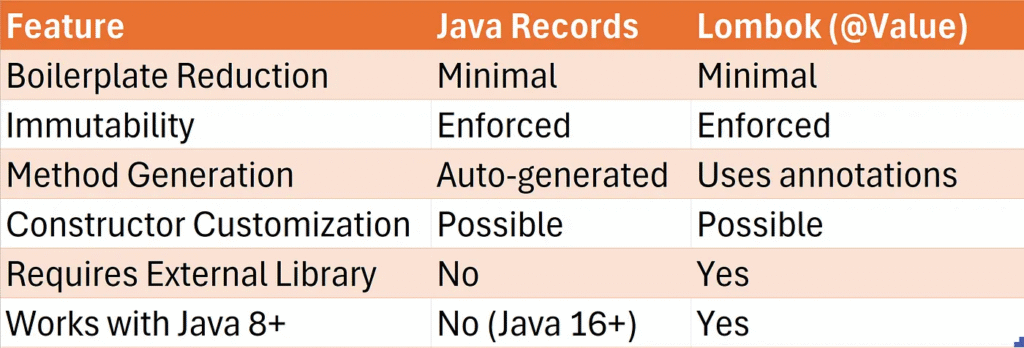Java has consistently evolved to provide developers with more expressive, concise, and efficient ways to write code. One of the major additions in Java 14 was the introduction of records — a new type of class that simplifies the creation of immutable data carriers. This article thoroughly explores Java records, including their syntax, features, use cases, limitations, and best practices.
What is a Java Record?
A record in Java is a special class designed to be a simple data carrier. It reduces boilerplate code by automatically generating commonly used methods like equals(), hashCode(), and toString().
Java records were introduced as a preview feature in Java 14, finalized in Java 16, and are now a permanent part of the Java language.
Why Were Records Introduced?
Before records, creating a simple data class in Java involved writing a lot of repetitive code:
public class Person {
private final String name;
private final int age;
public Person(String name, int age) {
this.name = name;
this.age = age;
}
@Override
public boolean equals(Object obj) {
if (this == obj) return true;
if (!(obj instanceof Person person)) return false;
return age == person.age && name.equals(person.name);
}
@Override
public int hashCode() {
return Objects.hash(name, age);
}
@Override
public String toString() {
return "Person{name='" + name + "', age=" + age + "}";
}
public String getName() {
return name;
}
public int getAge() {
return age;
}
}This is a lot of code. Java records simplify this class.
Syntax of Java Record
Using a record, the Person class can be written as:
public record Person(String name, int age) {}Explanation:
- Declares a record named
Person - Defines two fields:
nameandage - Automatically generates:
- A constructor
- Getters (but no “get” prefix, e.g.,
name()instead ofgetName()) equals(),hashCode(), andtoString()methods
Syntax of Lombok Value annotation
Using a Lombok, the Person class can be written as:
import lombok.Value;
@Value
public class Person {
String name;
int age;
public Person(String name, int age) {
if (age < 0) {
throw new IllegalArgumentException("Age cannot be negative");
}
this.name = name;
this.age = age;
}
}Explanation:
Value annotation automatically:
- Makes the class final
- Makes all fields private and final
- Generates getter methods (named exactly like the fields, just like records)
- Generates toString(), equals(), and hashCode()
- No setters (immutability by default)
Features of Java Records
1. Immutable by Default
- All fields in a record are
finaland cannot be modified after object creation.
2. Concise Syntax
- Removes boilerplate code like getters, constructors, and
toString().
3. Auto-generated Methods
- Records automatically implement
equals(),hashCode(), andtoString().
4. Can Implement Interfaces
- A record can implement an interface but cannot extend another class.
5. Compact Constructors
- Records allow constructors to be customized while still maintaining immutability.
Examples of Java Records
1. Using a Record
@Slf4j
public class RecordExample {
public static void main(String[] args) {
Person person = new Person("Alice", 30);
log.info(person.getName()); // Alice
log.info(String.valueOf(person.getAge())); // 30
log.info(String.valueOf(person)); // Person[name=Alice, age=30]
}
}2. Custom Constructor
By default, records provide a constructor matching the defined fields. However, developers can define a custom compact constructor:
public record Person(String name, int age) {
public Person {
if (age < 0) {
throw new IllegalArgumentException("Age cannot be negative");
}
}
}Here, we add validation to ensure the age is non-negative.
Exception in thread "main" java.lang.IllegalArgumentException: Age cannot be negative at com.example.programming.model.Person.<init>(Person.java:11) at com.example.programming.utils.example.RecordExample.main(RecordExample.java:12)
3. Implementing an Interface
Records can implement interfaces:
public interface Describable {
String describe();
}
public record Person(String name, int age) implements Describable {
@Override
public String describe() {
return name + " is " + age + " years old.";
}
}Limitations of Java Records
While records are helpful, they come with some restrictions:
1. Cannot Extend Classes
- A record cannot be inherited from another class. It only extends
java.lang.Recordimplicitly.
2. Immutable Fields
- Fields in a record cannot be changed after initialization.
3. No Additional Instance Variables
- All fields must be declared in the record header; extra instance variables are not allowed.
4. Cannot Modify Default Methods
- Records automatically provide
equals(),hashCode(), andtoString(), and overriding them requires careful implementation.
When to Use Java Records

Example: Using Java Record in a REST API
Records are great for defining API response models:
@RestController
public class UserController {
@GetMapping("/user")
public User getUser() {
return new User("John Doe", "john@example.com");
}
public record User(String name, String email) {}
}Here, User is a simple DTO with minimal code.

Comparison: Records vs Lombok
Many Java developers use Lombok to reduce boilerplate code. Here’s a comparison:

If you’re using Java 16 or newer, records are preferable since they are built into the language.
Conclusion
Java records provide a powerful and concise way to create immutable data structures while eliminating repetitive boilerplate code. They are best suited for data-centric classes such as DTOs, API responses, and configuration models. However, they do not replace regular classes, especially if mutability or inheritance is required.



